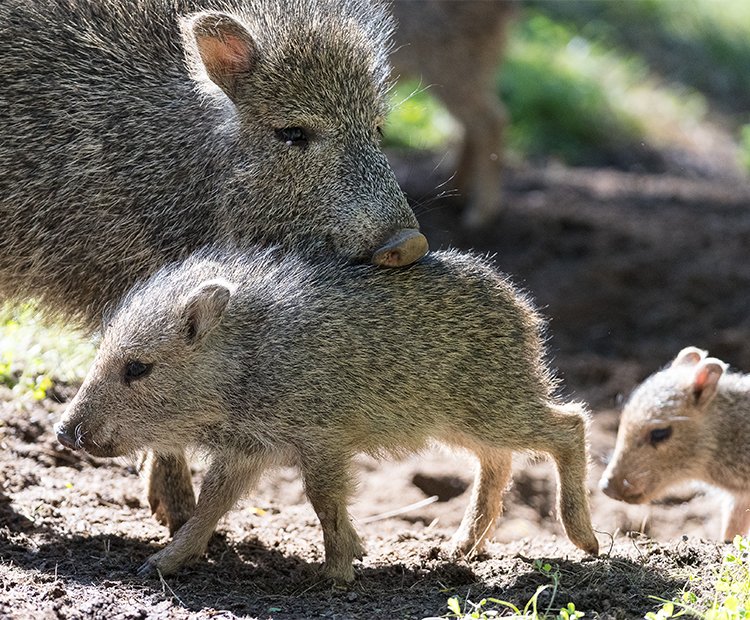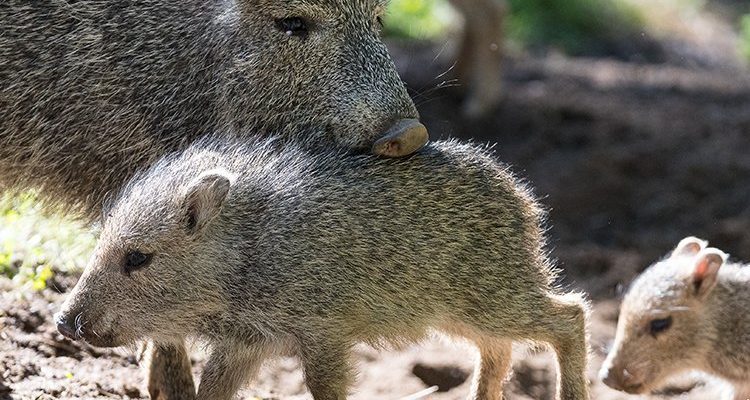
Peccaries are quite adaptable and tend to live in groups, which makes their social structure interesting. Picture a family dinner where everyone helps each other, from foraging for food to keeping watch for predators. With such a unique way of life, it’s essential to understand their habitats and distribution to appreciate these creatures fully.
Peccary Species and Their Ranges
There are three main species of peccaries: the collared peccary, the white-lipped peccary, and the Chacoan peccary. Each species has its specific habitat and geographical range.
– Collared Peccary: This is the most common species found across a wide range from the southern United States down to Argentina. They prefer areas with dense vegetation, like thorny forests or grasslands, where they can find food and safety.
– White-lipped Peccary: These guys are more selective, mainly living in tropical rainforests throughout Central and South America. They thrive in environments with abundant water and rich plant life.
– Chacoan Peccary: This intriguing species is somewhat of a rarity, living primarily in the dry Chaco region of Paraguay, Argentina, and Bolivia. They’ve adapted well to arid conditions but are under threat, making their conservation important.
Understanding these species helps paint a picture of where peccaries roam and how they adapt to their environments.
Key Habitats of Peccaries
Peccaries are versatile animals that can live in several types of habitats. Here’s a closer look at the different environments where you might find them:
– Tropical Rainforests: White-lipped peccaries love these lush habitats, where they’ve developed a taste for fruits and vegetation. The dense cover provides protection from predators, while the rich diversity of plants ensures a steady food supply.
– Savannas and Grasslands: Collared peccaries are commonly found in these open areas, where they forage for roots, tubers, and fruits. The open space allows them to spot danger from afar, while the varied vegetation offers plenty to eat.
– Dry Forests and Scrublands: In regions like the Chaco, the Chacoan peccary thrives in more arid conditions. These habitats may look sparse, but they’re surprisingly rich in resources for a species adapted to such dryness.
The adaptability of peccaries to different habitats is key to their survival. They have a knack for finding food and shelter in diverse environments.
Geographical Distribution of Peccaries
The geographical distribution of peccaries varies widely. Let’s break down where you can spot these fascinating animals:
– North America: Collared peccaries can be found in parts of the southern United States, particularly in Arizona, Texas, and New Mexico. They are a symbol of the unique wildlife found in these regions.
– Central America: You’ll find all three species of peccaries here, especially in countries like Nicaragua and Costa Rica. The lush rainforests provide critical habitats that support their lifestyle.
– South America: The white-lipped peccary is widespread in the Amazon rainforest, while the Chacoan peccary is confined to specific regions in Paraguay and Bolivia.
Each area provides a critical component to the overall distribution of peccaries. They occupy niches that ensure they can thrive even as their environments change.
Peccaries and Environmental Adaptability
One remarkable aspect of peccaries is their ability to adapt to various environments. They can manage different food sources and are quite social, often living in groups called sounders. Here’s how this adaptability plays a crucial role in their success:
– Social Structure: Living in groups helps them forage more effectively. They can cover more ground and find food faster. Plus, there’s safety in numbers—more eyes to watch for predators!
– Dietary Flexibility: Peccaries are omnivores, meaning they eat both plants and small animals. This flexibility allows them to thrive in environments where food might be scarce or seasonal.
– Habitat Preferences: While they prefer certain habitats, peccaries can adjust their living conditions based on availability. This adaptability is vital for their survival as climates change.
Recognizing these traits helps us appreciate how resilient and resourceful these animals are.
Threats to Peccary Habitats
Despite their adaptability, peccaries face numerous threats in the wild. Understanding these challenges is crucial for their survival:
– Habitat Loss: Deforestation for agriculture and urban development is a significant threat. As their habitats shrink, peccaries struggle to find food and shelter.
– Hunting and Poaching: In many areas, peccaries are hunted for their meat. This pressure can quickly diminish their populations, making conservation efforts even more critical.
– Climate Change: Changes in weather patterns can affect food availability and habitat conditions. Peccaries that can’t adapt quickly enough may face severe challenges.
Conservation efforts play an essential role in protecting these animals and their habitats. By understanding the threats they face, we can work together to support their populations.
Conservation Efforts for Peccaries
Protecting peccaries and their habitats is vital for their future. Here are some of the conservation efforts currently in place:
– Protected Areas: Many countries have established national parks and reserves to safeguard habitats. These protected areas provide a refuge for peccaries away from hunting and habitat destruction.
– Community Engagement: Involving local communities in conservation efforts is crucial. Educating people about the importance of peccaries helps create a sense of shared responsibility for their protection.
– Research and Monitoring: Ongoing research helps us understand peccary populations better. Tracking their movements and behaviors can inform conservation strategies, ensuring that efforts are effective.
By supporting these initiatives, we can help ensure that future generations will have the chance to marvel at these incredible animals in the wild.
The Importance of Peccaries in Their Ecosystems
Peccaries play essential roles in their ecosystems, often helping out in ways we might not immediately think about:
– Seed Dispersal: As they feed on fruits and plants, peccaries help disperse seeds across their habitats. This natural process is vital for plant regeneration and maintaining healthy forests.
– Soil Aeration: While foraging for food, peccaries dig in the ground, which helps aerate the soil. This action can promote healthier plant growth and contribute to overall ecosystem health.
– Food Source: Peccaries also serve as prey for larger predators. By being part of the food chain, they contribute to the ecological balance within their habitats.
Recognizing these roles emphasizes how interconnected wildlife and ecosystems are. Protecting peccaries is crucial not just for them but for the health of their environments, too.
In conclusion, peccaries are remarkable animals with diverse habitats and important roles in their ecosystems. Understanding where they live helps us appreciate their unique lives and the challenges they face. By working together to protect these incredible creatures and their homes, we can ensure they continue to thrive for years to come.

